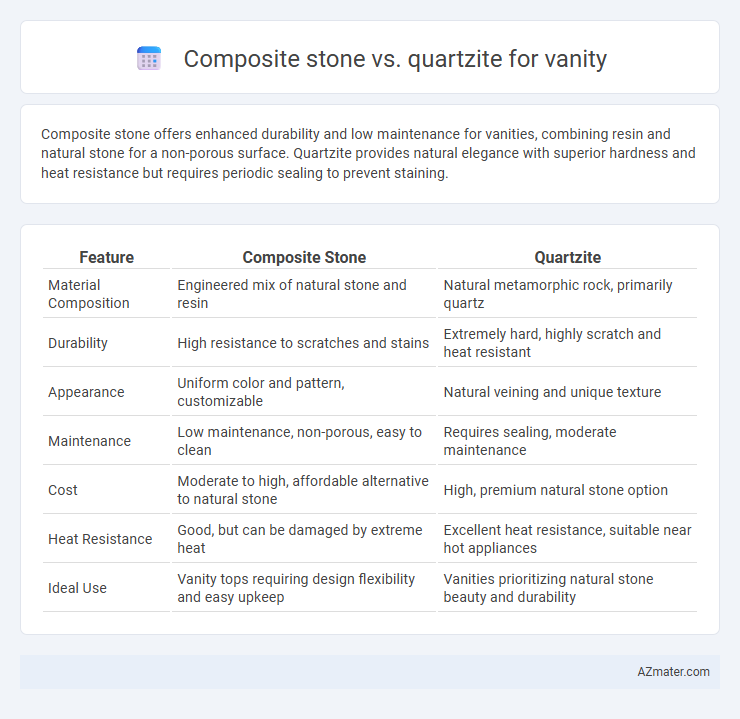Composite stone offers enhanced durability and low maintenance for vanities, combining resin and natural stone for a non-porous surface. Quartzite provides natural elegance with superior hardness and heat resistance but requires periodic sealing to prevent staining.
Table of Comparison
| Feature | Composite Stone | Quartzite |
|---|---|---|
| Material Composition | Engineered mix of natural stone and resin | Natural metamorphic rock, primarily quartz |
| Durability | High resistance to scratches and stains | Extremely hard, highly scratch and heat resistant |
| Appearance | Uniform color and pattern, customizable | Natural veining and unique texture |
| Maintenance | Low maintenance, non-porous, easy to clean | Requires sealing, moderate maintenance |
| Cost | Moderate to high, affordable alternative to natural stone | High, premium natural stone option |
| Heat Resistance | Good, but can be damaged by extreme heat | Excellent heat resistance, suitable near hot appliances |
| Ideal Use | Vanity tops requiring design flexibility and easy upkeep | Vanities prioritizing natural stone beauty and durability |
Introduction to Composite Stone and Quartzite
Composite stone, engineered from a blend of natural stone fragments and resins, offers a durable and low-maintenance surface ideal for vanity tops, resistant to stains and scratches. Quartzite, a natural metamorphic rock primarily composed of quartz, provides exceptional hardness and heat resistance, lending a luxurious and unique appearance to bathroom vanities. Both materials present excellent options for vanity surfaces, balancing aesthetic appeal with functionality.
Composition and Manufacturing Process
Composite stone for vanities consists of engineered materials combining crushed natural stone fragments with resins and pigments, allowing for consistent appearance and customizable designs. Quartzite is a natural metamorphic rock primarily composed of quartz grains fused under high heat and pressure, resulting in exceptional hardness and natural veining. While composite stone involves a controlled manufacturing process with binding agents for enhanced durability and stain resistance, quartzite undergoes minimal processing, relying on its natural formation for strength and aesthetic appeal.
Aesthetic Differences: Colors and Patterns
Composite stone vanities offer a wide range of vibrant, consistent colors and uniform patterns, ideal for modern and sleek bathroom designs. Quartzite provides natural, unique veining and earthy tones with intricate, swirling patterns that create a luxurious and timeless aesthetic. The choice between composite stone and quartzite largely depends on whether you prefer the controlled, customizable look of composite or the organic, natural beauty of quartzite.
Durability and Strength Comparison
Composite stone offers superior durability for vanity surfaces due to its engineered composition combining natural stone fragments with resin, enhancing resistance to scratches and stains compared to natural quartzite. Quartzite, a natural metamorphic rock, is exceptionally hard and heat-resistant but can be more prone to chipping or etching from acidic substances. When prioritizing strength and long-term durability, composite stone provides a more consistent, low-maintenance option, while quartzite delivers natural beauty with high hardness but requires regular sealing for protection.
Maintenance Requirements
Composite stone vanities require minimal maintenance due to their non-porous surface, resisting stains, scratches, and bacteria buildup, making them ideal for busy bathrooms. Quartzite, a natural stone, demands regular sealing to prevent staining and etching, with more careful cleaning routines involving pH-neutral products to maintain its polished appearance. Frequent upkeep for quartzite ensures its durability and visual appeal, while composite stone offers a low-maintenance, durable alternative for vanity surfaces.
Resistance to Stains, Scratches, and Heat
Composite stone vanities offer excellent resistance to stains and scratches due to their engineered composition of natural stone particles and resin, providing a non-porous surface that repels common bathroom substances and resists daily wear. Quartzite, a natural metamorphic rock, exhibits superior heat resistance and hardness, making it highly durable against scratches but can be more porous and prone to staining if not properly sealed. For a vanity, composite stone ensures easier maintenance and stain-resistant properties, whereas quartzite requires sealing to protect against stains but offers enhanced heat and scratch resistance with a more natural stone appearance.
Cost Analysis: Budget Considerations
Composite stone vanities generally offer a more budget-friendly option with prices ranging from $50 to $100 per square foot, making them ideal for cost-conscious homeowners. Quartzite, while more expensive at $70 to $150 per square foot, provides superior natural stone durability and aesthetic appeal, often justifying the higher initial investment. Maintenance costs for composite stone tend to be lower due to its non-porous nature, whereas quartzite may require periodic sealing to maintain its appearance and longevity.
Environmental Impact and Sustainability
Composite stone vanities, often made from engineered materials combining natural stone with resins, have a lower environmental impact due to reduced quarrying and more efficient manufacturing processes compared to quartzite, a natural stone requiring extensive mining and processing. Quartzite extraction involves significant energy consumption and landscape disruption, while composite stone production can incorporate recycled materials, enhancing sustainability. Choosing composite stone supports eco-friendly practices by minimizing resource depletion and promoting circular construction materials.
Installation Process and Flexibility
Composite stone offers a more straightforward installation process due to its uniformity and lighter weight, making it easier to cut and shape for custom vanity designs. Quartzite, being a natural stone, requires specialized tools and skilled labor to handle its hardness and variability, which can complicate installation and increase costs. Composite stone's flexibility in design and ease of installation make it a preferred choice for DIY projects, while quartzite is favored for durability and natural aesthetics despite installation challenges.
Which Material is Best for Your Vanity?
Composite stone offers excellent durability and stain resistance, making it a practical choice for vanities exposed to daily moisture and frequent use. Quartzite provides superior natural beauty with unique veining and higher heat resistance, ideal for luxury bathroom designs seeking long-lasting elegance. For optimal vanity performance, composite stone is best suited for low-maintenance needs, while quartzite excels in durability and aesthetic appeal in high-end applications.

Infographic: Composite stone vs Quartzite for Vanity
 azmater.com
azmater.com